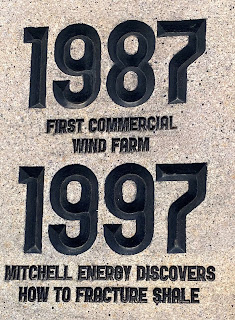March 22, 2021
Bob wanted to get up early (definitely earlier than I wanted to get up) to visit the I-20 Wildlife Preserve. I decided to sleep in and let him go by himself, and I was glad I did because when he got there, the park was closed and he had to turn around and come back.
We ended up getting on the road at about 9:30, heading southeast towards San Angelo, a distances of about 112 miles. One of the things that makes a driving trip like this one so much fun is that running into quirky things is almost inevitable
For example, we saw this huge metal thing being towed down the road that looked like an airplane wing. Bob figured out that it was a blade of a electricity-generating windmill. I read that the blades of a turbine windmill are 120 feet long. I can't imagine turning the corner with one of these in tow.




































